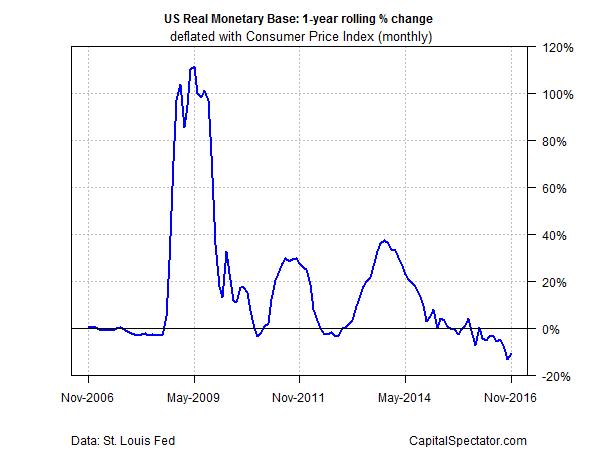Inflation expectations have been ticking higher lately, according to several sources, signaling that headline measures of year-over-year price indexes could reach the Federal Reserve’s 2% inflation target in 2017 for the first time in several years.
Market-based estimates of future inflation have been trending up in recent months, based on the yield spread between nominal and inflation-indexed Treasuries. The the yield spread on 10-year Treasuries, for instance, touched 1.98% on the first trading day of the year, based on daily data via Treasury.gov—close to the highest level in well over two years.
The Cleveland Fed’s inflation nowcast is even higher. The January 2017 estimate for the year-over-year change in the headline consumer price index is 2.28%, up from the 2.07% in December. The core CPI nowcast is a bit softer, but the current nowcast tops 2.0% as well. The key takeaway: this model’s anticipating that the 1.7% annual pace in headline CPI through November (the current report) will soon exceed the Fed’s 2.0% target.
That’s also the forecast via TradingEconomics.com’s econometric outlook for prices, which projects a rising trend for headline CPI’s annual changes in the months ahead.
Meanwhile, prices in the manufacturing sector are posting firmer numbers lately. “Input price inflation accelerated for the third time in the past four months during December,” IHS Markit advised in yesterday’s survey update for the US. “Moreover, the latest rise in average cost burdens was the sharpest since October 2014, which manufacturers mainly linked to greater raw material prices (especially metals).”
Russell Price, senior economist at Ameriprise Financial, tells Bloomberg that he was “a little bit surprised by the strength of the increase” in the ISM price index. “We’ve seen firmer commodity prices across the board, and maybe the expectations of stronger results may be influencing responses in the survey. Headline inflation should see an acceleration.”
Despite the recent rise in inflation expectations, the market is projecting that the Fed will leave interest rates unchanged at the next monetary policy announcement on Feb. 1. Fed funds futures are pricing in a 97% probability (as of Jan. 3) that the central bank will maintain the current target rate range of 0.50% to 0.75%, according to CME data.
Nonetheless, the Fed continues to squeeze the real (inflation-adjusted) base money supply, which implies that monetary tightening is ongoing. The M0 measure of money fell 10.9% in November vs. the year-earlier level—the ninth straight month of year-over-year declines and close to the deepest slide in more than half a century.
The current M0 decline follows years of extraordinarily high rates of growth, and so a fair amount of M0’s downside trend can be attributed to a mopping-up effort. Still, it’s clear that the Fed’s policy bias has shifted to a mildly hawkish stance.
Nothing’s written in stone, of course. But short of a sharp slowdown in economic growth (and/or ongoing strength in the US dollar), the rebound in inflation expectations looks set to continue and lay the groundwork for more interest rate hikes in the months ahead.



Pingback: Inflation Expectations Ticking Higher - TradingGods.net
Pingback: 01/04/17 – Wednesday’s Interest-ing Reads | Compound Interest-ing!
In such articles I believe one should mention that the Fed’s 2% target is for headline PCE inflation.